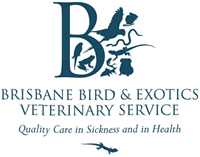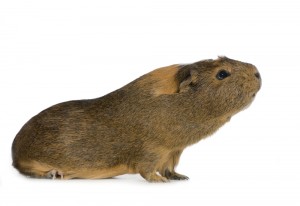N. A. Irlbeck – Department of Animal Sciences, Colorado State University, Fort Collins 80523-117
Rabbits are found in virtually every country in the world, providing protein, fiber, animal research, and companionship (third to dogs and cats). Because of an ability to utilize low-grain and highroughage diets, they have the potential to be a future protein source.
Abstract
Classified as an herbivorous nonruminant, rabbits have a simple, noncompartmentalized stomach along with an enlarged cecum and colon inhabited by a microbial population (primarily Bacteroides). Rabbits practice coprophagy, which enhances strategies of high feed intake (65 to 80 g/kg BW) and fast feed transit time (19 h), allowing rabbits to meet nutritional requirements. Coprophagy also increases protein digestibility (50 vs 75-80% for alfalfa). Feces are excreted on a circadian rhythm, and data indicate that the internal cycle differs when shifting from ad libitum to restricted feeding. Microbes digest cellulose (14% in rabbits vs 44% in cattle) in the hindgut of the rabbit, but the contribution of amino acids from microbial protein is thought to be minimal. Lysine and methionine may be limited in traditional diets, and urea is not utilized.
Acetate is the primary microbial VFA, with more butyrate than propionate. Unlike ruminants, more VFA are produced on starch than on forage diets; however, VFA provide limited energy for maintenance. Fiber is essential to maintain gut health, stimulate gut motility (insoluble fiber only), and reduce fur chewing. Low-fiber diets result in gut hypomotility, reduced cecotrope formation, and prolonged retention time in the hindgut. High-starch diets may be incompletely digested in the small intestine due to rapid transit times, resulting in enteritis. Low-energy grains like oats are preferred. Low-protein concentrations increase cecotrope consumption and high levels decrease it. Finely ground feeds lead to enteritis, so a coarse grind is recommended. Rabbits have an unusual calcium metabolism, absorbing Ca without vitamin D facilitation; the excess calcium is excreted in the urine (parathyroid hormone and calcitonin regulate serum Ca levels). Diets high in Ca (alfalfa based) may result in kidney damage for animals at maintenance. Correct feeding management based on the idiosyncrasies of the rabbit gastrointestinal tract will maximize production for future meat production. A balanced diet containing adequate fiber (20 to 25%), minimal starch, and optimum protein concentration is the key to preventing gastrointestinal distress.
Introduction
Domestic rabbits (Oryctolagus cuniculus) are found in virtually every country in the world, providing protein, fiber, research models, and companionship; they rank third in number to dogs and cats as companion animals in the United States. Almost everyone has had a rabbit in the backyard at one time or another. But have you ever taken the time to actually consider the physiological idiosyncrasies of the rabbit and how they apply to feeding? As a child, I was instructed to feed my rabbits alfalfa hay and an ear of corn. In the summer, I was “lucky” enough to have the chore of pulling grass for them. Today, pet owners are advised to feed a complete pelleted diet, supplemented with grass hay and small amounts of produce. Commercial rabbitries throughout the country feed a complete pelleted diet (alfalfa-based) with various supplemental feeds.
Rabbits can utilize low-grain and high-roughage diets (McNitt et al., 1996). Because rabbits are able to utilize this type of diet, are able to breed year-round, and have a “quick” generation interval, they are uniquely poised to provide animal protein for developing countries, where grain can only be justified for human use. It must be clarified, however, that rabbits are not able to survive solely on poor-quality, low-energy forages. Due to their small size and high metabolic rate, a high-quality forage is needed. So, what is the correct way to feed rabbits? An in-depth evaluation of the digestive tract of adult rabbits may help to understand potential complexities when feeding this unique animal.
Classification and Description of the Gut
Rabbits are herbivores, are concentrate selectors, and are classified as hindgut (cecum and colon) fermentors (Cheeke, 1987; McNitt et al., 1996). Because there are no mammalian enzymes to break down the cellulose components of their plant-based diets, rabbits as well as other herbivores have a symbiotic microbe population (primarily Bacteroides). Ruminants have a voluminous area (rumen) within the gastrointestinal tract where fiber fermentation occurs. The omasum limits the removal of fiber from the rumen until fermentation is complete. In horses, also a hindgut fermentor, the colon is the major site for the microbial population and fiber fermentation. Horses compensate for reduced fiber digestion by consuming more forage and increasing its passage rate through the gastrointestinal tract. Because of a smaller body size and higher metabolic rate than horses, rabbits rely on other adaptations for forage utilization (Cheeke, 1987).
In rabbits, the microbial population is found in the cecum. The rabbit cecum is very large, compared with the rest of the gut (Stevens and Hume, 1995) and forms a spiral that fills the abdominal cavity. The cecum has a capacity 10 times that of the rabbit’s stomach, about 40% of the gastrointestinal tract (Jenkins, 1999). Instead of completely fermenting fiber, rabbits utilize a mechanism to sort out indigestible fiber and expel it from the body, a process that is a specialized feeding strategy that overcomes poor-quality protein (Carabano and Piquer, 1998; Jenkins, 1999). This sorting mechanism occurs as digesta enter the rabbit large intestine and muscular contractions facilitate the separation of fiber and nonfiber (protein, soluble carbohydrates, etc.) fractions. A series of peristaltic (move fiber through colon) and antiperistaltic waves (move fluid and nonfiber components to cecum for fermentation) separate out nonfiber fractions for further fermentation in the cecum (Cheeke, 1987; Carabano and Piquer, 1998); particle size and density aid separation (Cheeke, 1994). The fiber components are voided from the body (day, or hard, feces) about 4 h after consumption of the diet (Cheeke, 1994). After fermentation of the nonfiber components in the cecum, a pellet is formed (called a cecotrope, also soft, or night, feces) that is voided from the body approximately 8 h after consumption of the diet (Cheeke, 1994). A neural response (Jenkins, 1999) or the strong odor of VFA (Stevens and Hume, 1995) in the cecotrope seem to stimulate its consumption directly from the anus. This practice of consuming cecotropes is called copraphagy, or cecotrophy (Cheek, 1987). In natural settings, copraphagy usually occurs during the day, opposite of feed intake and the voiding of hard feces, in a circadian rhythmic pattern (Carabano and Piquer, 1998; Jenkins, 1999), and is an integral part of the rabbit’s digestion process (Cheeke, 1994). If a rabbit is equipped with a collar preventing copraphagy, the digestion of the diet is significantly reduced, even when a highly digestible diet is fed.
Because of their small body size, if allowed to consume a diet ad libitum, rabbits will daily eat an amount that approximates 5% of their body weight in dry matter and drink about 10% of their body weight in water (Okerman, 1994). Even at this intake, if a rabbit were to consume only low-quality forages, there would be insufficient energy and nutrients to meet its metabolic requirements. However, if rabbits at maintenance are fed a high-quality pelleted diet for ad libitum consumption, they will become obese (Cheeke, 1994; Brooks, 1997). A recommended amount of 26 g of high fiber (25% crude fiber) pellet per kilogram of BW is recommended to maintain body condition (Jenkins, 1999). Rabbits require a diet of 2,200 kcal/kg of diet (as cited by Cheeke, 1994), or 2.2 kcal/g of diet. If a 3.64-kg rabbit is fed according to Jenkins’s recommendation (1999) of 26 g/kg BW, the animal will be consuming 208 kcal of energy (94.64 g × 2.2 kcal/g = 208 kcal). If a rabbit is allowed ad libitum consumption of the pelleted diet, 5% of BW, it will almost double Jenkins’s (1999) recommended allowance, resulting in a higher energy intake and ultimately obesity.
When allowed to select their own diet in a natural setting, rabbits will select the most tender, succulent plant parts or the plant parts that are most nutrientdense and lowest in available cell walls. Some researchers call animals that practice this type of eating behavior concentrate selectors, a practice that allows the animal to meet the dietary requirements for their high metabolic rate (Cheeke, 1994). Their chosen selections are low in fiber and high in carbohydrate and protein; therefore, a larger gut volume is not needed. Rabbits simply eliminate fiber as quickly as possible from their gastrointestinal tract. Rabbits have high feed intake (65 to 80 g/kg BW) and fast feed transit time (19 h), which enable them to consume lower-quality forages and still meet nutritional requirements (Carabano and Piquer, 1998).
Most problems seen in rabbit production (commercial and companion animal) involve the gastrointestinal tract. Enteritis is the primary gastrointestinal disorder, and it often results in diarrhea (Cheeke, 1994). This disorder is often a result of an imbalance in normal microflora in the gut, whether that imbalance is due to insufficient fiber, too much starch, or the addition of antibiotics to the diet. Understanding the idiosyncrasies of the rabbit gut and how dietary components affect that microbe population is a key to proper feeding management. These issues are discussed next.
Gut Microbes and Utilization of Fiber
As stated earlier, rabbits have a symbiotic microbe population found in the hindgut responsible for fiber fermentation. When compared with other herbivores, actual fiber digestion capability for rabbits is relatively low (14% for alfalfa hay in rabbits compared with 44% in cattle, 41% in horses, and 22% in hogs) (McNitt et al., 1996). The actual crude fiber component of most forages fed is only 20 to 25% (McNitt et al., 1996), depending on forage maturity. Obviously, the more mature a forage, the higher the crude fiber. Examples of crude fiber in forages from the United States-Canadian Tables of Feed Composition (NRC, 1982) are 23% in early bloom alfalfa (31% ADF, 40% NDF), 38% in mature alfalfa (44% ADF, 57% NDF), 28% in early bloom timothy (32% ADF, 61% NDF), and 32% in full-bloom bluegrass (38% ADF, 68% NDF). This is comparable to the range of 12 (low fiber) to 25% (high fiber) crude fiber found in rabbit pellets (Brooks, 1997). Other nonfiber fractions of forage, protein, and soluble carbohydrates are easily digested by rabbits.
In rabbits, dietary fiber has a critical role in maintaining gut health, stimulating gut motility (insoluble fiber only), reducing fur chewing, and preventing enteritis (McNitt, et al., 1996; Brooks, 1997). Rabbits need a minimum dietary fiber level of 20 to 25% to maintain gut health. Diets less than 20 to 25% fiber result in gut hypomotility, reduced cecotrope formation, prolonged retention time in the hindgut, and often enteritis (Cheeke, 1994; Jenkins, 1999). Composition of the hard feces and the cecotrope is influenced by the diet. If dietary fiber concentration increases, the fiber composition of the fecal pellets also increases. Thus, high-quality fiber is essential for gut health in rabbits (McNitt et al., 1996; Stein and Walshaw, 1996). Fiber fermentation in rabbits does not seem to be enhanced by coprophagy (as cited by Cheeke, 1994).
Microbes in rabbit gut produce VFA, as do microbes in the rumen of a cow. In rabbits fed a traditional alfalfa/corn diet, acetate is the primary volatile fatty acid produced by microbes, with more butyrate than propionate being formed. Butyrate is the preferred energy source for the hindgut (Stevens and Hume, 1995; Gidenne et al., 1998; Jenkins, 1999). Microbes in rabbits produce more VFA on starch-based diets than on forage diets (Cheeke, 1994). Stevens and Hume (1995) indicate that VFA provide a major energy source in rabbit colon.
Gut microflora of rabbits are sensitive to most antibiotics (McNitt et al., 1996). If antibiotics are fed, the microbe population is altered, favoring E. coli and Clostridia organisms that produce toxins harming the gut lining, causing diarrhea and enterotoxemia (Cheeke, 1994; Stein and Walshaw, 1996; Brooks, 1997). Antibiotics that may cause this effect include lincomycin, ampicillin, amoxicillin, procaine penicillin, cephalexin, erythromycin, clindamycin, tylosin, and metronidazole. The actual effect from each of the drugs will differ between animals (Stein and Walshaw, 1996). Oxytetracycline, virginiamycin (Cheeke, 1994), or tetracycline (Brooks, 1997) are exceptions and are used as growth promotants, and sulfaquinoxaline is to control coccidia (Brooks, 1997). Under no circumstances should the inophore monensin be fed to rabbits; it is toxic even at low concentrations (McNitt et al., 1996; Martin, 2000).
Utilization of Protein
In ruminants, microbial protein satisfies the major amino acid requirement for the animal. However, this is not true for rabbits. Even though amino acids produced by bacteria may be available via coprophagy (especially lysine, sulfur amino acids, and threonine; Carabano and Piquer, 1998), research has shown that microbial protein plays only a minor role in meeting a rabbit’s protein and amino acid needs (McNitt, 1996). The majority of microbial protein utilized by the animal is digested in the colon (Stevens and Hume, 1995). As a result, synthetic amino acids are often added to commercial rabbit diets to fully meet amino acid needs, particularly lysine and methionine, which may be limiting amino acids in traditional alfalfa-corn diets (McNitt et al., 1996). Cecotropes do, however, contain approximately 28% crude protein (Stevens and Hume, 1995).
Rabbits are able to digest protein in forages quite well; rabbits can digest 75 to 85% of alfalfa protein, whereas hogs digest less than 50% (McNitt et al., 1996). This capability of utilizing protein from a forage source may be an added asset in developing countries where less grain and protein sources are available for animal consumption. Urea is recycled by the rabbit large intestine in a manner similar to that occuring in the rumen (Stevens and Hume, 1995). However, when dietary urea is fed to rabbits, it is not well utilized by microbes. Prolonged feeding of 0.5% urea in the diet of rabbits will result in liver or kidney lesions (Cheeke, 1994). Urea is converted to ammonia in rabbit gut, and when absorbed, it results in toxicity.
Ingestion of cecotropes is influenced by dietary protein and energy. When an animal is fed a low-energy diet, cecotrope ingestion is maximized (Jenkins, 1999). When an animal is fed a diet for ad libitum consumption, dietary protein and fiber concentration affect cecotrope consumption. Low levels of dietary protein fed to rabbits increase cecotrope consumption and high levels of protein decrease consumption, which seems to be a proteinsparing mechanism (Cheeke, 1994). Coprophagy has been found to increase protein digestibility (50 vs 75 to 80% for alfalfa) of forages in rabbits. As indicated earlier, feces are excreted according to a circadian rhythm. Data indicate that the internal cycle differs when shifting from ad libitum to restricted feeding, which compromises growth. Care should be taken when feeding high levels of dietary protein because excess protein may increase cecal ammonia levels, causing an increase in cecal pH (Cheeke, 1994). This rise in pH may allow pathogens to flourish and may increase the potential for enteritis.
Utilization of Starch
High-starch diets are often incompletely digested in rabbit small intestine due to rapid transit times (McNitt et al., 1996). Incomplete chemical digestion of the starch results in the availability of starch for microbial fermentation (Stevens and Hume, 1995). Excess starch in the gut results in an extremely rapid growth of microbes. If toxin-producing microbes (primarily Clostridium spiroforme) are in residence, high levels of starch may lead to enteritis and possible death (McNitt et al., 1996; Jenkins, 1999). Because of potential incomplete starch digestion, low-energy grains such as oats are preferred over corn or wheat (Cheeke, 1994). Grains processed too finely can lead to rapid bacterial fermentation of the starch and cause enterotoxemia. Thus, a coarse grind is recommended. The addition of copper sulfate (125 to 250 ppm) to rabbit diets sometimes lowers the incidence of enteritis (Cheeke, 1994). Copper sulfate is commonly used in swine and poultry diets and acts by inhibiting the growth of pathogenic bacteria.
Pellet Quality
Rabbits seem to perform better when fed pellets than when they are fed mixed grains or textured feeds, primarily because the animals are not able to sort out preferred items (Cheeke, 1994). For example, pelleted dehydrated alfalfa is preferred to alfalfa in its natural form. Rabbits, like most other animals, will select only the alfalfa leaves and leave the stems uneaten. This feeding practice results in a low-fiber diet and potential enteritis. Pellets need to be hard and durable, because rabbits prefer not to eat the fines. If an animal does eat too many fines or if the particle size is too small, there will be an increase in retention time in the gut, reduced gut motility, and enteritis. Large indigestible fiber particles are needed for normal cecal-colonic motility (Cheeke, 1994). Hypomotility of the gut predisposes an animal to enteritis. Feeding pellets of small diameter (0.5 cm) results in greater feed wastage. Maertens and Villamide (1998) recommend a pellet length for rabbits of 0.8 to 1.0 cm, because longer pellets will cause greater breakage and production of smaller pellets. McNitt et al. (1996) suggest that a solid and firm pellet of 0.63 cm in length and 0.47 cm in diameter is optimum for rabbits.
Calcium Metabolism
Rabbits have an unusual calcium metabolism, absorbing calcium without vitamin D facilitation and activation of calcium-binding proteins in the gut (McNitt et al., 1996; Jenkins, 1999), resulting in excess calcium being excreted in the urine. In most mammals, less than 2% of dietary Ca is excreted in the urine, but in rabbits it is much higher. In one study cited by Jenkins (1999), the fractional excretion of Ca was 44% when animals were fed a “typical” commercial diet. Because rabbits can absorb Ca without the facilitation of vitamin D, a mechanism is needed to regulate serum Ca levels. Parathyroid hormone and calcitonin are thought to prevent serum Ca levels from becoming dangerously high due to dietary influence. Diets high in calcium (alfalfa-based) may result in kidney damage for animals at maintenance levels (Cheeke, 1994) because homeostatic mechanisms are not as effective as in other species. Prolonged high dietary calcium will result in calcification of soft tissues such as aorta and kidney (Cheeke, 1994) and formation of kidney stones. This calcification is intensified if rabbits are supplemented with vitamin D, as is often found with commercial rabbit pellets.
Implications
Feeding a traditional alfalfa and corn diet or an alfalfabased pelleted diet is not the key to feeding or managing the rabbit gut for optimal production and maintenance. Traditional alfalfa is high in protein and calcium, which are both of concern for rabbit production. Corn is high in starch, and high levels of starch result in enteritis. Alfalfa is recommended for growing rabbits; however, one should feed mature animals a maintenance diet of grass hay with less protein and calcium along with minimal amounts (26 g) of high-fiber (25% crude fiber) pellets per kilogram of body weight. Amounts of high-fiber pellets can be increased as energy demands for gestation and lactation increase. Ultimately, correct feeding of rabbits includes high fiber from grass hay, low starch, and moderate protein and calcium levels. This feeding strategy helps maintain balanced gut microbial populations and coincides with potential feed sources available in developing countries.
Literature Cited
- Brooks, D. 1997. Nutrition and Gatrointestinal Physiology. In: E. V. Hillyer and K. E. Quesenberry (ed.) Ferrets, Rabbits and Rodents–Clinical Medicine and Surgery. p 169. W.B. Saunders Company, Philadelphia.
- Carabano, R., and J. Piquer. 1998. The Digestive System of the Rabbit. In: C. de Blas and J. Wiseman (ed.) The Nutrition of the Rabbit. p 1. CABI Publishing, London.
- Cheeke, P. R. 1987. Rabbit Feeding and Nutrition. Academic Press, New York.
- Cheeke, P. R. 1994. Nutrition and Nutritional Diseases. In: P. J. Manning, D. H. Ringler and C. E. Newcomer (ed.) The Biology of the Laboratory Rabbit. 2nd ed. p 321. Academic Press, New York.
- Gidenne, T., R. Carabana, J. Garcia, and C. de Blas. 1998. 5. Fibre Digestions. In: C. de Blas and J. Wiseman (ed.) The Nutrition of the Rabbit. p 69. CABI Publishing, London.
- Jenkins, J. R. 1999. Feeding Recommendations for the House Rabbit. Veterinary Clinics of North America: Exotic Animal Practice. vol. 2. p 143. W.B. Saunders Company, Philadelphia.
- Maertens, L., and M. J. Villamide. 1998. 13. Feeding Systems for Intensive Production. In: C. de Blas and J. Wiseman (ed.) The Nutrition of the Rabbit. p 241. CABI Publishing, London.
- Martin, N. 2000. Personal Communication. Nutritionist, Ranchway Feeds, Fort Collins, Colorado.
- McNitt, J. I., P. R. Cheeke, N. M. Patton, and S. D. Lukefahr. 1996. Rabbit Production. Interstate Publishers, Inc., Danville, IL.
- NRC. 1982. United States-Canadian Tables of Feed Composition. 3rd ed. National Academy of Press, Washington, DC.
- Okerman, L. 1994. Diseases of Domestic Rabbits. 2nd ed. Blackwell Scientific Publications, Oxford.
- Stein, S., and S. Walshaw. 1996. Rabbits. In: K. Laber-Laird, M. M. Swindle, and P. Flecknell (ed.) Handbook of Rodent and Rabbit Medicine. p 183. Pergamon Press, England.
- Stevens, C. E., and I. D. Hume. 1995. Comparative Physiology of the Vertebrate Digestive System. 2nd ed. Cambridge University Press, Cambridge, United Kingdom.
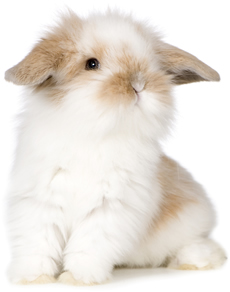 Cats & Hairballs
Cats & Hairballs



 Seed
Seed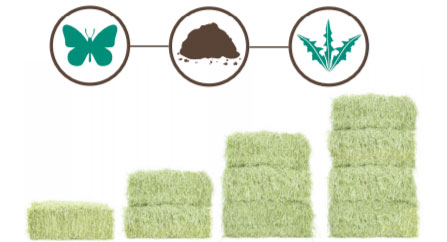
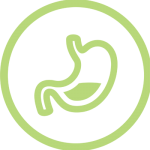 Digestive
Digestive Dental
Dental Mental
Mental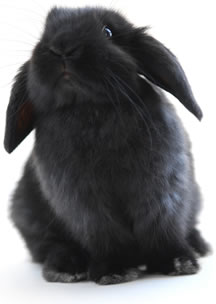 First, let’s address the fibre issue. Rabbits are hind gut fermentors meaning they digest much of their food in the caecum and colon (large intestine), which are at the end of the digestive tract. In the rabbit, the caecum (in humans our appendix is our caecum) is a large blind-ended sac located at the junction of the small and large intestine. The caecum is about 10 times as large as the stomach and makes up approximately 40% of the digestive tract. Within the caecum, bacteria and protozoa aid digestion of foods taken in by the rabbit.
First, let’s address the fibre issue. Rabbits are hind gut fermentors meaning they digest much of their food in the caecum and colon (large intestine), which are at the end of the digestive tract. In the rabbit, the caecum (in humans our appendix is our caecum) is a large blind-ended sac located at the junction of the small and large intestine. The caecum is about 10 times as large as the stomach and makes up approximately 40% of the digestive tract. Within the caecum, bacteria and protozoa aid digestion of foods taken in by the rabbit. Dr. Peter Fisher is owner and director of the Pet Care Veterinary Hospital in Virgina Beach, Virginia.
Dr. Peter Fisher is owner and director of the Pet Care Veterinary Hospital in Virgina Beach, Virginia.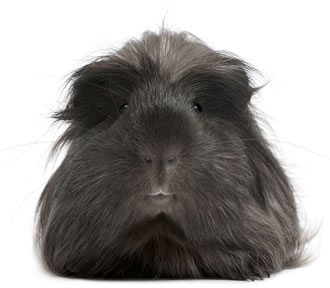 Digestive System
Digestive System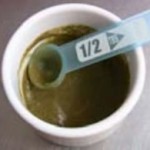
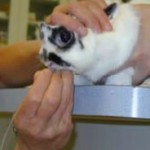
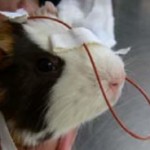
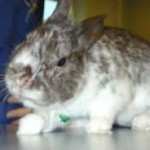
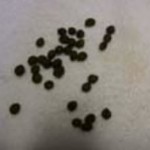
 Dawn Hromanik
Dawn Hromanik